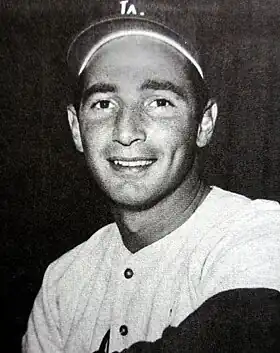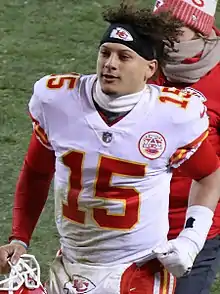The S. Rae Hickok Professional Athlete of the Year award, known as the Hickok Belt, is a trophy that was awarded from 1950 to 1976 (27 years) to the top professional athlete of the year in the United States, and then re-established in 2012. It was created by Ray and Alan Hickok[1] in honor of their father, Stephen Rae Hickok, who had died unexpectedly in 1945[1] and had founded the Hickok Manufacturing Company of Rochester, New York, which made belts—hence the choice of a belt for the trophy.[2]
The trophy was an alligator-skin belt with a solid-gold buckle, an encrusted 4-carat (800 mg) diamond, and 26 gem chips. It was valued at over $10,000 in the currency of the time[3] (US$90,000 to $140,000 in 2011 dollars)[1] and its presentation was a major event in sporting news of the day.[4]
For the first 21 years, from 1950 to 1970, it was awarded in Rochester at the annual Rochester Press-Radio Club dinner (and continues today). After the Hickok company was taken over by the Tandy Corporation, the award was presented in larger cities such as Chicago or New York. The last award was made in 1976.
In 2010, Tony Liccione, the president of the Rochester Boxing Hall of Fame, announced plans to reinstate the Hickok Belt starting in 2012.[5] The mold for the belt starting in 1951 (the first belt in 1950 misspelled Hickok's name as "Ray") was found and planned to be used again.[5] Liccione invited the 18 surviving belt winners (except O. J. Simpson, who at the time was incarcerated in Nevada) to the Comeback Dinner, which was held on October 16, 2011 at St. John Fisher College.[5][6]
Since being re-established in 2012, the award has been based on a vote by the National Sports Media Association;[7] however, there have been no public award ceremonies or belt presentations.[8] A 20-member panel chooses one athlete each month, with the twelve monthly winners being eligible for the award at the end of the calendar year.[7] Of the awards given since 2012, two have been presented to LeBron James and two to Patrick Mahomes.
Winners

For a biographical sketch of each winner from 1950 to 1976, see footnote[9]
Revived belt
.jpg.webp)

References
- 1 2 3 "The Storied History of the Award that Made Sports History: The Backstory on the Hickok Belt, the Crown Jewel of the Sports World". HickokBelt.com. Liccione Enterprises. Retrieved January 11, 2017.
- ↑ Morrell, Alan (October 23, 2016). "Whatever Happened To ... the Hickok Belt". Democrat and Chronicle. Rochester, New York: Gannet Company. pp. 8A–9A. Archived from the original on October 23, 2020. Retrieved October 24, 2016.
- ↑ "Hickok Award to Yankee Star". The Windsor Daily Star. Associated Press. January 22, 1957. p. 18. Retrieved October 18, 2011.
- ↑ Matthews, Bob (October 12, 2010). "Hickok Belt is returning to Rochester". Democrat and Chronicle. Rochester, New York. Gannett Company. pp. 1A, 4A. Archived from the original on October 15, 2010. Retrieved October 14, 2010.
- 1 2 3 Bradley, Steve (October 13, 2010). "Hickok Belt mold to be used again". Democrat and Chronicle. Rochester, New York. Gannett Company. pp. 1D, 2D. Archived from the original on October 15, 2010. Retrieved October 14, 2010.
- ↑ "The Belt is Back". Hickok Belt official website. Liccione Enterprises. Retrieved December 26, 2017.
- 1 2 Adams, Thomas (September 19, 2011). "Efforts underway to bring back the Hickok Belt". Rochester Business Journal. Rochester, New York. Archived from the original on March 20, 2012. Retrieved September 19, 2011.
- ↑ Morrell, Alan. "Whatever Happened To ... the Hickok Belt". commercial appeal. commercialappeal.com. Retrieved December 26, 2017.
- ↑ "The Sports Legends on Sports' Most Prestigious Short List: Meet the 26 Winners of the Original The Hickok Belt Award". HickokBelt.com. Liccione Enterprises. Retrieved January 11, 2017.
External reference
- Official website
- Pitoniak, Scott (2010). Jewel of the Sports World: The Story of the Hickok Belt.
- History of the Hickok Belt at the Library of Congress Web Archives (archived 2002-02-23)